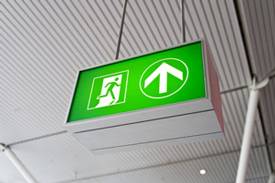 Businesses are ready for many types of disasters. There are (hopefully) smoke detectors on the ceiling, a recently inspected sprinkler system, emergency lights in the hallways and a well-marked exit path. Even in your home, you probably have a plan in case you need to evacuate your family. Nobody likes disasters, but if you’re prepared you’ll feel safer and more likely to survive. These same rules apply to social media disasters as well.
Businesses are ready for many types of disasters. There are (hopefully) smoke detectors on the ceiling, a recently inspected sprinkler system, emergency lights in the hallways and a well-marked exit path. Even in your home, you probably have a plan in case you need to evacuate your family. Nobody likes disasters, but if you’re prepared you’ll feel safer and more likely to survive. These same rules apply to social media disasters as well.
As consumers become more and more connected, their complaints can pile up or become viral, putting you and your business in the hot seat. As businesses also become more connected, there is danger of a poorly worded blog post from the CEO or even a rude comment from an employee on Twitter. Being ready for a social media disaster lowers the chance of a mishap taking place, reduces the amount of damage to your brand name and is a must for your external communication efforts.
Start with a “family” meeting. Get everyone involved.
When I say everyone should be involved, I mean everyone. Every company should have a policy defining the type of behavior that is – and is not – tolerated on social networks.
If social media is something you are truly serious about, a community manager or agency partner should manage the brand’s voice on social media by coordinating with advertising, public relations, marketing and management. The community manager should also be in charge of monitoring the brand’s image on social networking sites, blogs and forums, and flag any comments that require a response.
Install “smoke detectors.” Monitor social networks.
By watching the conversations that take place on social networks such as Twitter, YouTube and Facebook you’ll be able to find negative comments, posts and videos about your brand in real time.
Tools like Radian6 and SocialMention allow you to scour the social web for mentions of your brand. Information gathered from these tools can help detect recurring issues customers are experiencing with your business. These tools can also be used to track buzz, discover your top influencers and assist with sales or lead generation.
Evacuation plans: be ready to respond.
If a true social media disaster happens, you need to be ready right away: in these cases, time is everything. An issue can go from zero to 60 in a matter of hours. A timely response or apology about the issue can help deter further negative feedback and calm consumers’ nerves. Where can you post a public response? How quickly can you get it posted? Many companies have blogs, Facebook pages and Twitter accounts that allow for immediate publication.
We also suggest that you have simple responses to common issues ready to go, but take care to personalize each response as they come up.
Controlled chaos: provide a place for feedback.
Many people who complain about products and services in social media spaces/on social networking sites do so for a number of reasons. Perhaps they couldn’t get what they wanted over the phone, maybe it’s late at night and tech support is closed. Providing a forum where your customers can post concerns or complaints helps keep these complaints in an environment you have control over.
Learn by example.
Social media disasters have happened to many companies. The worst thing you can do is avoid the issue once it comes up. How should you respond? Take a look at these examples of how others handled difficult situations:
- Moms’ backlash against a Motrin ad.
- Domino’s Pizza employees post an offensive video.
- United Airlines breaks a guitar.
These are just three of many examples of crisis management in social media. Comment below to share some of your own experiences dealing (or not dealing) with negative comments or a full-on social media crisis.








